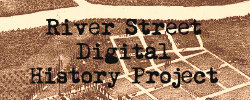
Madry’s grandmother Erma Hayman lived in this house for decades. It is one of the few remaining historical buildings in the River Street Neighborhood
Dick Madry’s great grandparents came to Idaho from Missouri sometime in the 1890s. Lured to Nampa to do railroad work, Madry’s great grandparents had 13 children and initially lived in a farmstead near Nampa. He was raised by his grandmother, Erma Hayman, who moved to Boise in the 1930s, bought a house in the 1940s, and lived there until 1968 (Click Here to read about Erma Hayman’s life in River Street)
River Street was known for its illicit activity, but many former residents were reluctant to acknowledge this. While it was not a positive part of life in the neighborhood, Madry remembered the goings on in those “joints”. He remembered “Pistol” Johnson’s entrepreneurial ventures including Blackjack’s Barbeque, operating as an informal pawnbroker, and several “shady” activities. Despite these illicit ventures, Johnson played an important role in the neighborhood by providing money to those that needed it. Recalling the gambling and prostitution houses along Pioneer Street (the Pioneer Walkway), Madry had the following to say:
“It wasn’t just after hours either. There were several along what is now the Pioneer Street corridor…There were some on South 13th that I remember.”
Before these houses became Joints, they were regular residential houses. Madry recalls hearing from his grandmother that Senator William Borah used to visit the Pioneer Street area in order to connect with his working class constituents. Madry had several relatives that used to live there before they became houses of ill-repute.
As a child, Madry always had chores and homework. He typically had to haul wood or coal and water or mow the yard upon returning home from school. He also took care of the garden, pulling weeds and watering the vegetables. Each family in River Street grew their own garden in the yard of their house. Madry remembers that it didn’t matter what race you were or whether or not you owned or rented your home, almost everybody in River Street had a garden. In addition to the garden, Madry’s family also had fruit trees: peaches, cherries, and apples that were also canned for later consumption. They also kept chickens. When asked what happened if the tree died, Madry said his family simply bought another one.
People in the neighborhood did things together and racial lines were crossed in the neighborhood. Both black and white cooperated and worked together. Madry remembers that, in the neighborhood, people of all races got along well and there was little discrimination between residents. He remembers River Street being a safe place where a family could raise their children without having to worry about overt racial discrimination.
Click Here to hear other reminiscences with former River Street residents.
Please Contact Us if you have any questions or comments.
